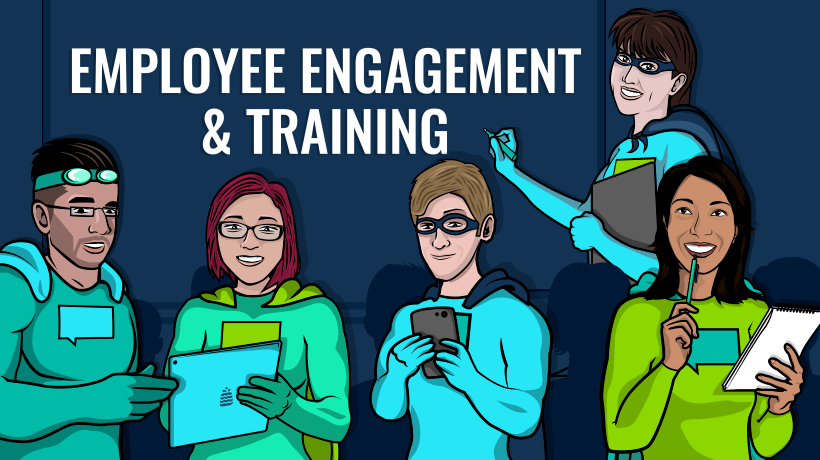How To Achieve Employee Engagement: The Road To Effective Training
So, you’ve got a fully motivated workforce of employees who love their jobs and work hard to help you achieve your organizational objectives. Go you! You can stop reading this and go back to enjoying the vibrant and stimulating culture that’s made you so successful! However, if Gallup’s research is anything to go by, you’re more likely to be plagued by retention problems1, stunted growth2, and employees with no sense of purpose3. The issue of employee engagement has been one of the trickiest riddles in business for years. Sadly, it’s an issue that’s more often swept under the carpet and even ignored at the highest levels4.
Although the trends are alarming, outliers like Virgin and John Lewis have shown what’s possible when they forge a meaningful connection5 with their employees. Maybe poor performance has cost your organization so much that you don’t have the capital to invest in engagement, but studies show that it’s engagement that impacts performance6, not the other way around.
The Impact Of Employee Engagement
Employee engagement is often deprioritized, but a little engagement is proven to generate great improvements. Gallup’s Q12® Meta-Analysis Report7 shows that companies with engaged employees consistently outperform those without in the areas of customer loyalty, profitability, and productivity.
For a lot of business managers, the big question is how to improve engagement and encourage innovation at the ground level. As with so many things, the answer is staring them in the face - the greatest weapon against employee apathy is the training program.
For a lot of businesses, training and development is one of the few communication tools they have. Aside from giving the employees the knowledge they need to do their jobs, training is closely connected to performance reviews. In many cases, these reviews are the only opportunity that managers and employees have to share their opinions about the work environment in a structured way. When it comes to engaging employees, communication is vital and the training program is, by-and-large, an underutilized communications tool.
However, the traditional model of employee training isn’t enough...
Training For The 21st Century
Although classroom events and face-to-face sessions have their place, they have little impact on their own. Training needs to be reinforced on a regular basis and the best way to do that is online. Learning Management Systems have become the norm in most companies, but their potential is seldom realized.
Luckily, leading-edge learning technology developers have been thinking outside of the box and creating platforms that do more than just deliver content and report on learner progress. Here are just a few of the tricks they’ve been using to make their training more effective:
1. Gamification
The use of game mechanics in non-game environments has improved results in areas of customer loyalty8, marketing9, and even fitness10. In online learning, it’s particularly useful in several ways. Virtual badges exploit the urge to collect and they give learners a virtual trophy cabinet for all of their learning goals.
The learners can also earn achievements for multiple consecutive logins, meaning they’ve got one more reason to access their training program. Leaderboards are a core part of any game and the competitive instinct is often enough to make employees go beyond the call of duty in their training.
2. Social Features
When it comes to securing employee engagement, social functionality is an absolute must. Having an online social network in your business improves teamwork and communication - two things which, by themselves, can have a drastic effect on engagement and business processes as a whole.
3. Discussion Groups
At a time when job-hopping is becoming a prominent trend, knowledge loss is a bigger problem than ever. Forums and discussion groups can be used to identify the real experts in your business and capture intellectual capital before it walks out the door. Letting the employees contribute to this bank of organisational knowledge gives them a greater sense of ownership, meaning they’re more likely to be engaged with their jobs.
4. Mobile
Now that mobile usage has overtaken desktop usage11, businesses can’t afford to rely solely on learning platforms that don’t have mobile capabilities. If they want to engage with their employees and take full advantage of the benefits of mobile learning, they need to adapt to the way their people behave, without expecting the employees to adapt instead.
Final Word
Employee engagement isn’t something that happens by itself - it needs to be driven by somebody. It’s not just a switch you can flick either; it’s a continuous conversation between everyone in the business, from the CEO down to the fresh-faced newbie. The right learning platform can give businesses a one-stop-shop for delivering training, boosting performance and generating a culture that empowers everyone.
References:
- Many Millennials Are Job-Hoppers -- But Not All
- Managing in Tough Financial Times: Does Engagement Help?
- Millennials Not Connecting With Their Company's Mission
- Corporate Culture Crisis: New Study Reveals 98% of CEOs Ignore Annual Employee Engagement Survey Results
- 6 Companies That Get Employee Engagement – And What They Do Right
- HBR: How Employee Engagement Affects Business Outcomes
- Gallup Q12® Meta-Analysis Report
- 3 Ways Retailers Can Use Gamification to Drive Customer Loyalty
- Why Gamification Works: How Brands are Marketing With Fun
- Zombies, Run!
- Mobile web usage overtakes desktop for first time









